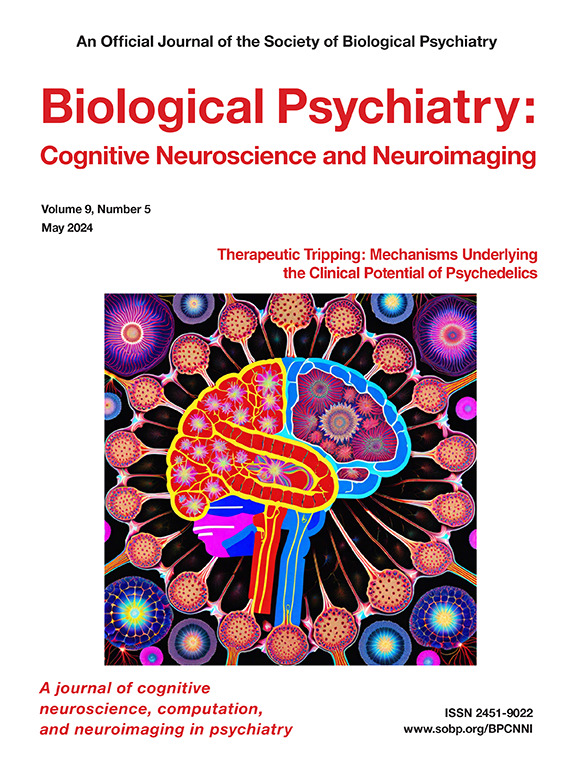基于早期精神病患者眼动熵的异常扫描模式。
IF 4.8
2区 医学
Q1 NEUROSCIENCES
Biological Psychiatry-Cognitive Neuroscience and Neuroimaging
Pub Date : 2025-07-01
DOI:10.1016/j.bpsc.2024.06.003
引用次数: 0
摘要
背景:限制性扫描路径模式被认为可以解释精神分裂症患者的异常扫描模式。在此,我们计算了熵分数(利用注视数据来测量眼球运动的统计随机性),以量化参与者处理图像刺激的策略性和随机性:86名首发精神分裂症患者(FES)、124名精神病临床高危人群(CHR)和115名健康对照组(HCs)完成了自由观看35张静态图像(每张图像显示10秒)的眼动追踪检查和认知评估。我们比较了总体熵分和不同条件下熵分的组间差异。此外,我们还研究了熵值与症状和认知功能之间的相关性:结果:FES 组和 CHR 组的总体熵值相对于 HC 组有所增加,而且这些差异在 0∼2.5 秒内就已经很明显。此外,与 HCs 相比,CHR 组在观看低意义图像时表现出更高的熵。此外,0∼2.5 秒内的熵与 FES 组的负性症状、CHR 组的注意力/警觉性评分以及所有三组的处理速度和注意力/警觉性评分均有显著相关性:结论:研究结果表明,FES 和 CHR 比 HC 扫描图片更随意,策略性更弱。这些模式还与临床症状和神经认知相关。本研究强调了眼动熵测量作为早期精神病神经生理学标记的潜力。本文章由计算机程序翻译,如有差异,请以英文原文为准。
Abnormal Scanning Patterns Based on Eye Movement Entropy in Early Psychosis
Background
Restricted scan path mode is hypothesized to explain abnormal scanning patterns in patients with schizophrenia. Here, we calculated entropy scores (drawing on gaze data to measure the statistical randomness of eye movements) to quantify how strategical and random participants were when processing image stimuli.
Methods
Eighty-six patients with first-episode schizophrenia (FES), 124 individuals at clinical high risk (CHR) for psychosis, and 115 healthy control participants (HCs) completed an eye-tracking examination while freely viewing 35 static images (each presented for 10 seconds) and cognitive assessments. We compared group differences in the overall entropy score, as well as entropy scores under various conditions. We also investigated the correlations between entropy scores and symptoms and cognitive function.
Results
Increased overall entropy scores were noted in the FES and CHR groups compared with the HC group, and these differences were already apparent within 0 to 2.5 seconds. In addition, the CHR group exhibited higher entropy than the HC group when viewing low-meaning images. Moreover, the entropy within 0 to 2.5 seconds showed significant correlations with negative symptoms in the FES group, attention/vigilance scores in the CHR group, and speed of processing and attention/vigilance scores across all 3 groups.
Conclusions
The results indicate that individuals with FES and those at CHR scanned pictures more randomly and less strategically than HCs. These patterns also correlated with clinical symptoms and neurocognition. The current study highlights the potential of the eye movement entropy measure as a neurophysiological marker for early psychosis.
求助全文
通过发布文献求助,成功后即可免费获取论文全文。
去求助
来源期刊

Biological Psychiatry-Cognitive Neuroscience and Neuroimaging
Neuroscience-Biological Psychiatry
CiteScore
10.40
自引率
1.70%
发文量
247
审稿时长
30 days
期刊介绍:
Biological Psychiatry: Cognitive Neuroscience and Neuroimaging is an official journal of the Society for Biological Psychiatry, whose purpose is to promote excellence in scientific research and education in fields that investigate the nature, causes, mechanisms, and treatments of disorders of thought, emotion, or behavior. In accord with this mission, this peer-reviewed, rapid-publication, international journal focuses on studies using the tools and constructs of cognitive neuroscience, including the full range of non-invasive neuroimaging and human extra- and intracranial physiological recording methodologies. It publishes both basic and clinical studies, including those that incorporate genetic data, pharmacological challenges, and computational modeling approaches. The journal publishes novel results of original research which represent an important new lead or significant impact on the field. Reviews and commentaries that focus on topics of current research and interest are also encouraged.
 求助内容:
求助内容: 应助结果提醒方式:
应助结果提醒方式:


